- Effect of Mechanical and Toughening Characteristics of Epoxy/Carbon Fiber Composite by Polyamide 6 Particles, CTBN Addition Technology
Sung-Youl Bae*, Kyo-Moon Lee*,**, Sanjay Kumar**, Ji-Hun Seok*,***, Jae-Wan Choi*,****, Woo-Hyuk Son*,*****, Yun-Hae Kim**†
* Aero Transport Material Center, Korea Institute of Ceramic Engineering & Technology
** Department of Ocean Advanced Materials Convergence Engineering, Korea Maritime and Ocean University
*** Major of Mechanical Engineering, Korea Pusan National University
**** Graduate School of Convergence Science, Pusan National University
***** Major of Mechanical Engineering, Korea Gyeongsang National University- Polyamide 6 입자 및 CTBN 첨가 기술에 따른 에폭시/탄소섬유 복합재의 강인화 효과 및 기계적 특성
배성열*· 이교문*,**· Sanjay Kumar**· 석지훈*,***· 최재완*,****· 손우혁*,*****· 김윤해**†
This article is an open access article distributed under the terms of the Creative Commons Attribution Non-Commercial License (http://creativecommons.org/licenses/by-nc/4.0) which permits unrestricted non-commercial use, distribution, and reproduction in any medium, provided the original work is properly cited.
Epoxy-based carbon fibers reinforced plastic (CFRP) exhibit limitations in their suitability for industrial applications due to high brittleness characteristics. To address this challenge, extensive investigations are underway to enhance their toughness properties. This research focuses on evaluating the toughening mechanisms achieved by Polyamide 6 particles(p-PA6) and Carboxyl-Terminated Butadiene-Acrylonitrile (CTBN) elastomer, with a specific emphasis on utilizing minimal additive quantities. The study explores the impact of varying concentrations of p-PA6 and CTBN additives, namely 0.5, 1, 2.5, and 5 phr, through comprehensive Mode I fracture toughness and tensile strength analyses. The inclusion of p-PA6 demonstrated improvements in toughness when introduced at a relatively low content of 1phr. This improvement manifested as a sustained fracture behavior, contributing to enhanced toughness, while simultaneously maintaining the material's tensile strength. Furthermore, the investigation revealed that the incorporation of p-PA6 affected in particle aggregation, thus influencing the overall toughening mechanism. Incorporation of CTBN, an elastomeric modifier, exhibited a pronounced increase in fracture toughness at higher concentrations of 2.5 phr and beyond. However, this increase in toughness was accompanied by a reduction in tensile strength, resulting in fracture behavior similar to conventional CFRP exhibiting brittleness. The synergy between p-PA6, CTBN and CFRP appeared to marginally enhance tensile strength under specific content conditions. As a result of this study, optimized conditions for the application of the p-PA6, CTBN toughening technology have been identified and established
에폭시계 탄소섬유복합재는 고유의 높은 취성특성으로 인해 산업 응용에 적합성에 한계로 인성 특성을 향상시키기 위한 광범위한 연구가 진행되고 있다. 본 연구는 최소 함량을 활용하는 데 중점을 두고 PA6입자(p-PA6)와 CTBN에 의한 인성 메커니즘을 평가하는 데 초점을 맞춰 Mode I 파단 인성 및 인장강도 분석을 통해 다양한 농도의 p-PA6와 CTBN 첨가제, 즉 0.5, 1, 2.5 및 5 phr의 영향을 평가하였다. p-PA6는 1 phr의 비교적 낮은 비율에서 인성이 강화되었으며, 인장강도를 유지하면서 동시에 향상된 인성에 기여하는 지속적인 파단 거동으로 나타났다. 또한, p-PA6의 입자 응집에 영향에 의해 전체적인 인성 메커니즘에 영향을 미치는 것을 확인하였다. CTBN첨가는 2.5 phr 이상의 높은 농도에서 인성의 증가하나, 인장강도의 감소를 동반하고 취성을 나타내는 기존의 복합재와 유사한 파단 거동을 관찰하였으며, p-PA6, CTBN 두 첨가 기술은 특정 농도 조건에서 인장강도를 미세하게 향상시키는 것으로 확인하였다. 해당 결과를 통해 p-PA6, CTBN 강화 기술 적용에 최적화된 조건이 확립하였다
Keywords: CFRP, 나일론6 입자(PA6 particles), 액상 고무첨가제(CTBN elastomer), 파괴인성 분석(Facture toughness analysis)
에폭시를 기반으로하는 탄소섬유복합소재(Carbon fiber reinforced Thermoset composite; CFRP)는 내열·내화학, 비강도, 비강성, 기계특성이 우수하여 여러 모빌리티 산업에서의 구조재로 적용되고 있다. 하지만 에폭시의 높은 가교결합에 의한 취성특성이 강하여 충격하중에 대한 면내∙외의 균열 성장에 취약하여 교량, 건축분야, 보강근과 같은 특성산업에서의 적용이 어렵다.
CFRP의 층간파괴 인성을 강화 기술 중 2차상 도입을 통한 매트릭스 강화는 Carboxyl terminated butadiene acrylonitrile(CTBN)와 같은 고무계 소재, 무기계(Alumina, Silica), 폴리머계(Polyetheretherketone, Polytetrafluoroethylene) 소재를 이용한 연구가 보고되고 있으며[1-4], CTBN 첨가는 에폭시에 용해되어 화학적 결합 및 고른 분산에 용이하여 기존에 비해 20~50% 강인화 가능한 소재로 평가[1,2]되고 있으나, 주로 5~30 phr 고함량 조건에서 강인화 성능을 향상시키기 위한 연구가 수행되고 저함량에 대한 강인화 거동 및 효과에 대한 평가가 부족하다.
산업에서 범용으로 사용되는 PA6는 반결정 소재로 기계적 특성뿐만 아니라 내화학, 난연성이 우수한 고분자이며, 표면의 친수성 특성으로 에폭시와의 계면 결합특성이 우수한 것으로 보고[5-8]되고 있어 강인화제로 응용이 가능하나, 주로 나노섬유, veil 형태로 적용한 연구가 주로 수행되며[3,5,9], 범용적으로 접근이 가능한 입자 형태에 대한 연구는 부족한 것으로 보인다.
따라서 본 연구에서는 CTBN의 저함량 첨가 조건에 따른 강인화 효과 및 거동을 검토하여 강인화를 위한 조건을 도출하고자 하며, 또한 PA6입자를 적용을 통한 CFRP의 강인화 효과 및 거동 분석을 CTBN과 비교 검토하여 p-PA6의 응용 가능성을 확인하고 한다.
2.1 재료 및 실험방법
본 연구에서는 도레이社 T700로 직조된 일방향 직물(200gsm)을 GM Composite 사에서 제공받았으며, 국도화학社 KFR-5121, KFH-9581LV를 사용하였다. 강인화제는 CTBN 및 p-PA6 사용하였으며, 각각 HUNTSMAN社 Hypro 1300X13 CTBN, GoodFwllow 社 AM30-PD-000110 제품을 구입하였다. CFRP 성형 공정, 첨가량 및 분산 조건은 Table 1에 정리하여 나타내었으며, 첨가제의 영향을 평가하기 위하여 Mode I Interlaminar fracture toughness (ASTM D5528) 파괴인성 시험, 인장시험(ASTM D3039) 및 광학현미경을 통한 형태학적 분석을 수행하였다.
3.1 Mode-I 파괴인성 특성 결과
Fig. 1은 첨가제의 조건에 따른 (a) 초기균열 파괴인성(GIc)과 (b) 균열성장 파괴인성(GI)의 Delamination Resistance Curve 결과로 Mode I - Modified Beam Theory으로 계산되었다. Fig. 1a에서 p-PA6의 0.5 phr, 1 phr 조건에 따라 GIc 값이 각각 6%, 14% 증가하였으며 이후 2.5 phr, 5 phr 조건에 따라 각 1.4%, -6%로 점차 감소되는 것을 확인하였다. CTBN 첨가는 저함량(0.5 phr, 1.0 phr)에서 약 1.4% 증가로 효과가 없었으며, 고함량(2.5 phr, 5 phr)부터 24%, 39%로 효과적인 강인화 경향이 관찰되었다. Fig. 1b에서, p-PA6는 1.0 phr에서 전체적으로 증가하였으며, 이후 점차 감소하여 5.0 phr 조건에서 Neat 시편과 유사해지는 경향이 관찰되었다. CTBN 참가 조건에서 0.5 phr, 1.0 phr은 Neat 시편과 유사한 GI 값으로 큰 변화는 없으며, 2.5 phr 이상부터 증가하는 경향이 확인되었다. 해당 결과로 p-PA6 입자를 이용한 강인화는 1.0 phr 범위 내 적용이 필요하며, CTBN은 2.5 phr 이상의 함량이 필요한 것으로 확인되었다.
Fig. 2, 3는 Mode-I 시험의 (a) Load-Displacement 그래프, 시험편 표면에서의 (b) 광학현미경 결과 및 인성강화 메커니즘 모식도이며, 첨가제에 따른 균열 성장 거동을 분석하였다. Fig. 2a는 p-PA6 첨가에 따른 파괴거동으로 a1~a4 (Blue ellipse) 구간과 같이 Stick과 Slip 사이에 연속적인 파괴(Stable propagation)가 발생하는 것을 확인하였으며[10], 함량이 증가할 수록 연속적인 파괴가 지배적인 현상으로 관찰되었다. 이러한 파괴 거동은 Fig. 2b와 같이 균열이 성장하는 동안 p-PA6에 의해 지속적으로 회절, 변형되어 균열의 급진적인 전진이 억제되어 발생한 것으로 사료된다[11]. Fig. 3a는 CTBN 첨가에 따른 파괴거동은 균열의 Stick과 Slip이 반복되는 일정한 패턴을 가지며, Neat CFRP와 유사한 거동이 관찰되었다. 액상 고무계 CTBN 첨가에 따른 파괴거동은 Fig. 3b와 같이 화학적 모식도와 같이 CTBN의 카르복실기와 에폭시 고리가 화학적 결합으로 사슬을 형성하고 하중에 의해 변형(균열 성장)될 때, 형성된 사슬 내 CTBN이 소성변형을 하여 보다 많은 에너지를 흡수하게 되어 인성 특성이 강하되는 것으로 사료된다[12].
3.2 기계적 특성 평가 결과
Fig. 4는 강인화에 따른 인장강도 결과로, p-PA6 1.0 phr 조건에서 인장강도가 6% 증가하였으며, 이후 함량이 증가할 수록 강도가 감소하는 경향이 관찰되며, 5.0 phr 조건에서는 9% 감소가 되었다. CTBN 첨가도 유사한 경향으로, 1 phr에서 약 5% 증가 후 2.5 phr 부터 강도가 감소하기 시작하여 5 phr 조건에서 약 6% 강도 저하가 발생하였다. p-PA6, CTBN 첨가 시 공통적으로 1 phr 조건에서 인장강도가 소량 증가한 후 점차 감소하는 경향이 관찰되었으며, 이러한 경향은 p-PA6와 CTBN 첨가가 에폭시 수지와의 계면결합력이 우수하나 상대적인 밀도에 의해 부정적인 영향을 미치는 것을 보여준다. CTBN 경우, 카르복실기가 탄소섬유 표면의 사이징제 또는 주변 에폭시와 화학적반응에 의한 사슬결합으로 섬유와 수지 간 계면결합특성이 강화되어 영향을 미치는 것으로 사료된다[13]. 이후 함량이 증가할수록 기계적 특성이 약한 CTBN이 에폭시 내 밀도가 증가하여 에폭시의 사슬결합 밀도가 낮아짐에 따라 기계적 특성이 약화되어 하중 전달 메커니즘에 부정적인 영향을 미친 결과로 판단된다[12,14-19]. p-PA6를 통한 기계적 특성의 경우, 입자와 매트릭스 간의 상호작용이 특성에 영향을 미치는 요인으로 보고되고 있으며[20], p-PA6와 에폭시는 친수성 특성으로 두 소재간 우수한 계면결합특성을 가지고 있다[21,22]. 이에 에폭시에 가해진 하중은 p-PA6에 전달되어 분산[23]되고 하중에 의한 미세한 균열이 입자에 회절되어 섬유-수지 계면 파손이 억제됨에 따라 강화된 것으로 사료된다[5,24]. 또한, Fig. 4(b)에서 5 phr 이상에서는 p-PA6의 응집이 대량으로 관찰되며, 이러한 응집체는 수지 간 비교적 낮은 계면 결합 형성 및 응집체 간 약한 결합력으로 응력집중에 쉽게 파손되어 균열이 성장하는 공극(결함)으로 작용하여 강도 특성에 부정적인 영향을 미치는 것으로 확인하였다[8,20,24].
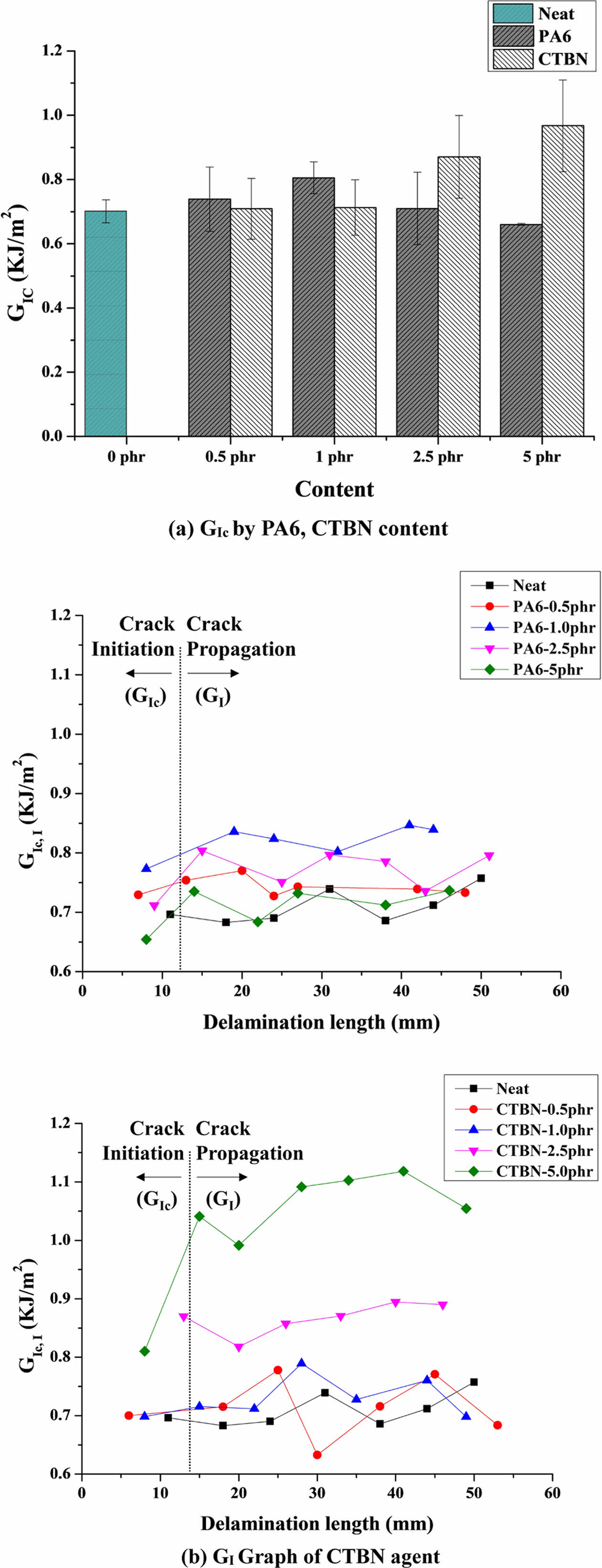
|
Fig. 1 The results of (a) Interlaminar fracture toughness (GIc) and (b) Delamination resistance curve of Mode-I |
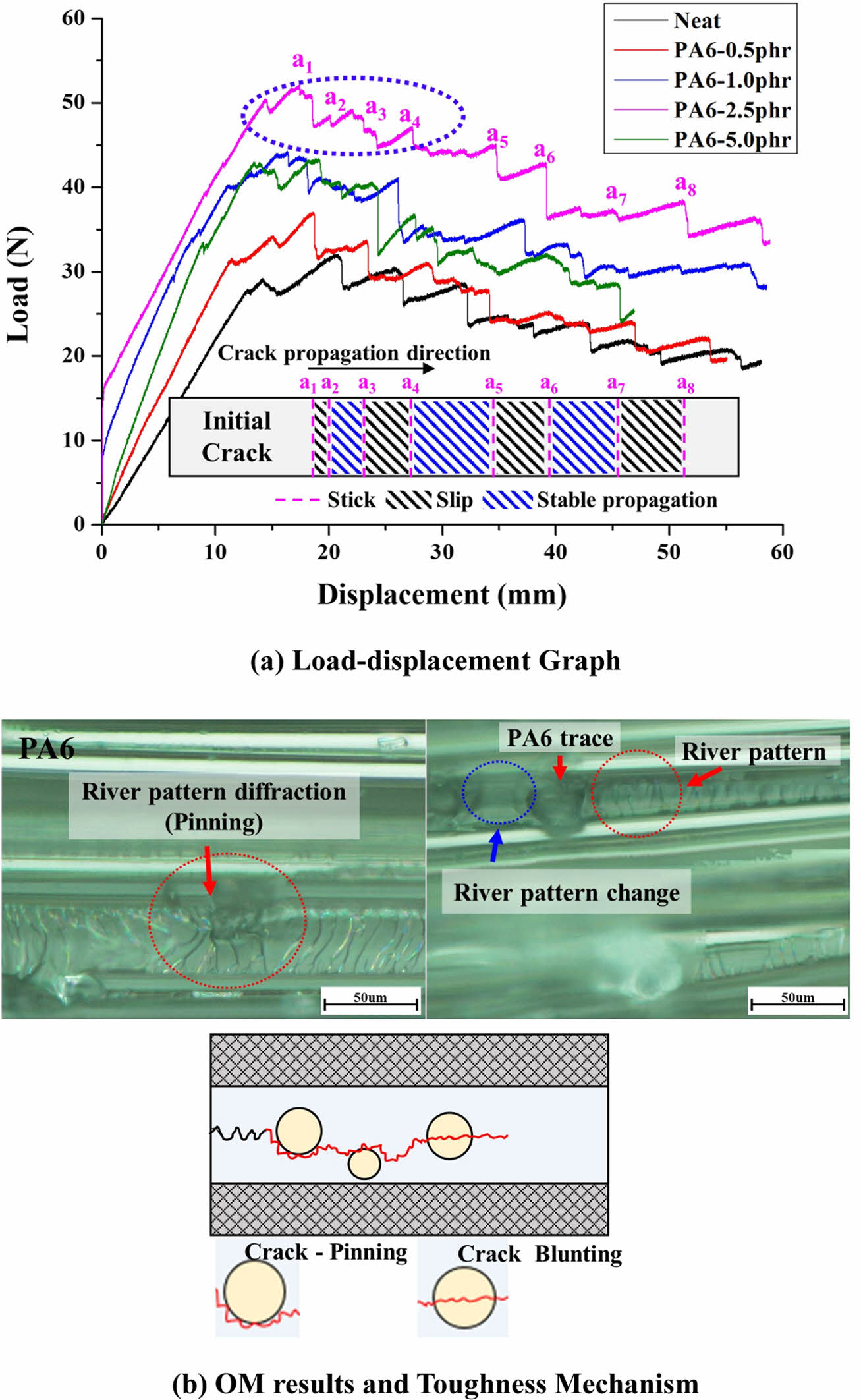
|
Fig. 2 The results of (a) Load-displacement and (b) Optical microscope, Toughness mechanism of p-PA6 modified CFRP |
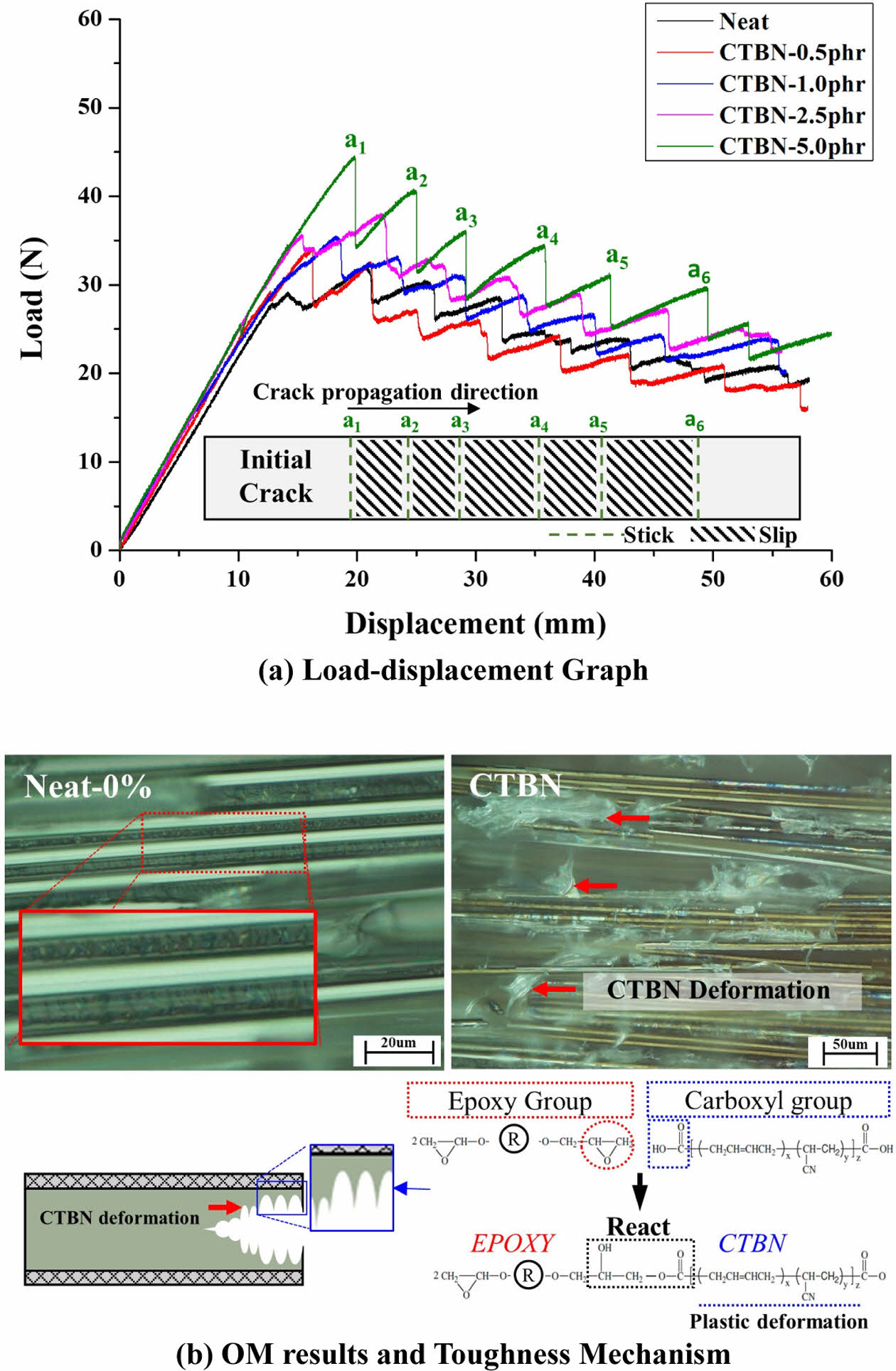
|
Fig. 3 The results of (a) Load-displacement and (b) Optical microscope, Toughness mechanism of CTBN modified CFRP |
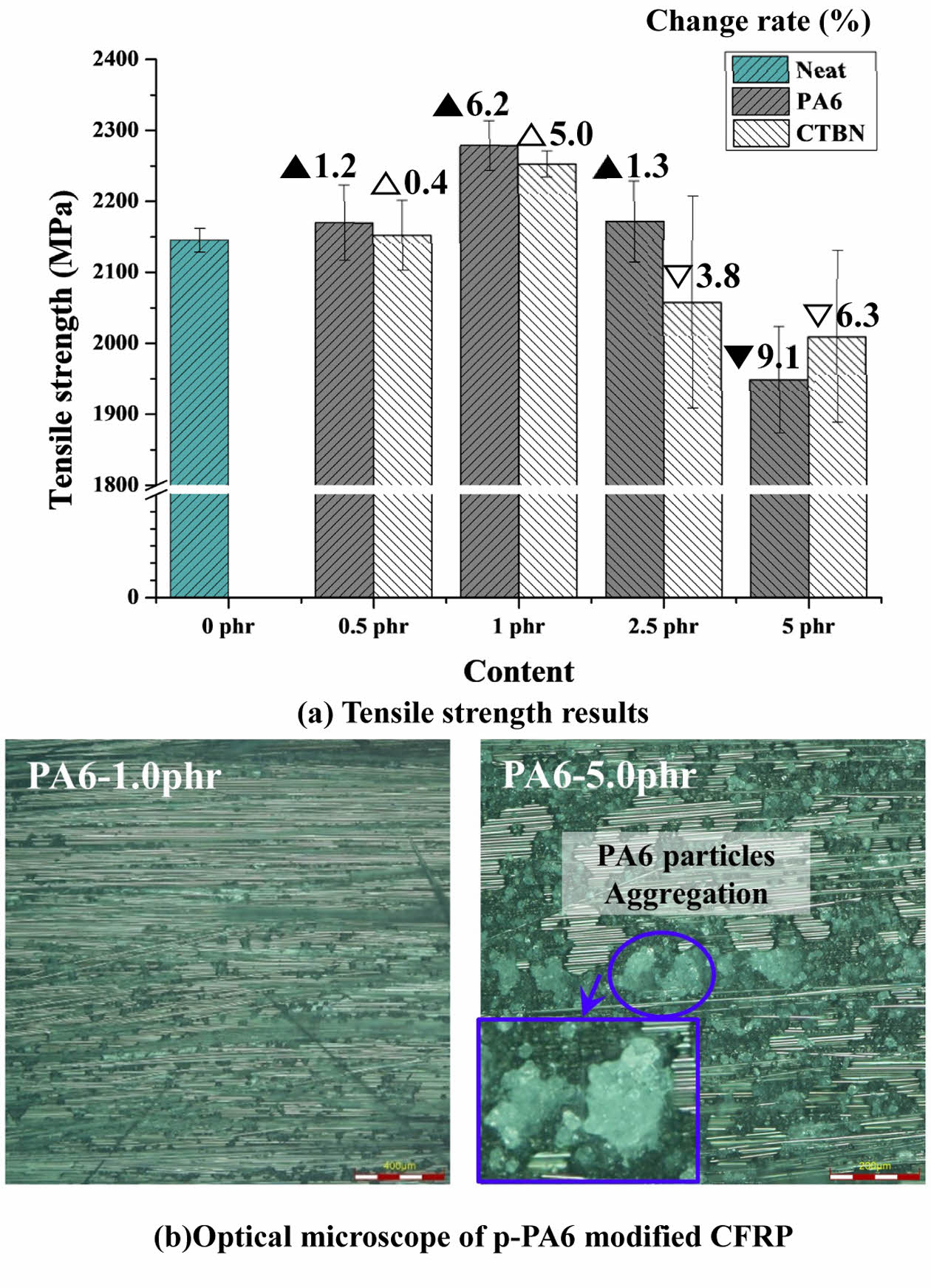
|
Fig. 4 The results of (a) Tensile properties and (b) Optical microscope, p-PA6 aggregation in PA6 modified CFRP |
본 연구는 CFRP의 강인화를 위한 p-PA6, CTBN 첨가 기술의 저함량(0.5~5.0 phr)에 따른 강인화 효과 및 거동을 비교분석을 수행하였다. p-PA6 입자를 통한 강인화 기술은 1 phr의 낮음 함량에서 인성/기계적 특성에 효과가 있으며, 층간 파괴에너지를 지속적으로 흡수함으로써 급진적인 층간파괴 거동에서 연속적인 파괴 거동이 관찰되었다. 또한, 응집으로 인한 결함에 인성/기계특성에 큰 영향을 받으며, p-PA6 첨가기술은 낮은 함량(1 phr) 조건이 우세한 것으로 확인하였다. CTBN은 낮은 첨가 조건에서 그 영향성이 없으며, 2.5 phr 이상에부터 강인화 효과를 가지나 강도 저하가 동시에 발생하였다. 하지만 인성 증가 대비 강도 저하가 미미한 것을 확인하였으며, CTBN은 비교적 높은 함량(5 phr) 조건이 우세한 것으로 확인하였다.
본 연구는 2023년도 중소벤처기업부의 기술개발사업 지원에 의한 연구임[RS-2023-00207683].
- 1. Gabr, M.H., Abd Elrahman, M., Okubo, K., and Fujii, T., “A Study on Mechanical Properties of Bacterial Cellulose/epoxy Reinforced by Plain Woven Carbon Fiber Modified with Liquid Rubber,” Composites Part A: Applied Science and Manufacturing, Vol. 41, No. 9, 2010, pp. 1263-1271.
-

- 2. Hayes, B.S., and Seferis, J.C., “Toughened Carbon Fiber Prepregs Using Combined Liquid and Preformed Rubber Materials,” Polymer Engineering & Science, Vol. 41, No. 2, 2001, pp. 170-177.
-

- 3. Monteserín, C., Blanco, M., Murillo, N., Pérez-Márquez, A., Maudes, J., Gayoso, J., and Vilas, J.L., “Effect of Different Types of Electrospun Polyamide 6 Nanofibres on the Mechanical Properties of Carbon Fibre/epoxy Composites,” Polymers, Vol. 10, No. 11, 2018, pp. 1190.
-

- 4. Kinloch, A.J., and Taylor, A.C., “The Toughening of Cyanate-ester Polymers Part I Physical Modification Using Particles, Fibres and Woven-mats,” Journal of Materials Science, Vol. 37, 2002, pp. 433-460.
-

- 5. Hsieh, T.H., Kinloch, A.J., Masania, K., Sohn Lee, J., Taylor, A.C., and Sprenger, S., “The Toughness of Epoxy Polymers and Fibre Composites Modified with Rubber Microparticles and Silica Nanoparticles,” Journal of Materials Science, Vol. 45, 2010, pp. 1193-1210.
-

- 6. Kim, S.H., and Park, S.J., “Effect of Graphitic Nanofibers on Interfacial Adhesion and Fracture Toughness of Carbon Fibers-Reinforced Epoxy Composites,” Composites Research, Vol. 34, No. 2, 2021, pp. 82-87.
-

- 7. Wu, J., Li, C., Hailatihan, B., Mi, L., Baheti, Y., and Yan, Y., “Effect of the Addition of Thermoplastic Resin and Composite on Mechanical and Thermal Properties of Epoxy Resin,” Polymers, Vol. 14, No. 6, 2022, pp. 1087.
-

- 8. Gu, H., Ma, C., Liang, C., Meng, X., Gu, J., and Guo, Z., “A Low Loading of Grafted Thermoplastic Polystyrene Strengthens and Toughens Transparent Epoxy Composites,” Journal of Materials Chemistry C, Vol. 5, No. 17, 2017, pp. 4275-4285.
-

- 9. Chaudhary, S., Parthasarathy, S., Mangla, V., Kumar, D., and Roy, P.K., “Toughening of Epoxy with Preformed Polyethylene Thermoplastic Filler,” Polymer-Plastics Technology and Engineering, Vol. 54, No. 9, 2015, pp. 907-915.
-

- 10. Zhou, Y., Xiao, Y., Wu, Q., and Xue, Y., “A Multi-state Progressive Cohesive Law for the Prediction of Unstable Propagation and Arrest of Mode-I Delamination Cracks in Composite Laminates,” Engineering Fracture Mechanics, Vol. 248, 2021, pp. 107-684.
-

- 11. Chaudhary, S., Parthasarathy, S., Mangla, V., Kumar, D., and Roy, P.K., “Toughening of Epoxy with Preformed Polyethylene Thermoplastic Filler,” Polymer-Plastics Technology and Engineering, Vol. 54, No. 9, 2015, pp. 907-915.
-

- 12. Akbari, R., Beheshty, M.H., and Shervin, M., “Toughening of Dicyandiamide-cured DGEBA-based Epoxy Resins by CTBN Liquid Rubber,” Iranian Polymer Journal, Vol. 22, 2013, pp. 313-324.
-

- 13. Xie, Z., Tang, X., Yang, P., Sun, M., Yang, K., and Huang, Q., “Carboxyl-terminated Butadiene-acrylonitrile-modified Carbon Paper for Use of Gas Diffusion Layer in PEM Fuel Cells,” International Journal of Hydrogen Energy, Vol. 40, No. 41, 2015, pp. 14345-14352.
-

- 14. Ramos, V.D., Da Costa, H.M., Soares, V.L., and Nascimento, R.S., “Modification of Epoxy Resin: A Comparison of Different Types of Elastomer,” Polymer Testing, Vol. 24, No. 3, 2015, pp. 387-394.
-

- 15. Bian, X., Tuo, R., Yang, W., Zhang, Y., Xie, Q., Zha, J., and He, S., “Mechanical, Thermal, and Electrical Properties of BN–Epoxy Composites Modified with Carboxyl-terminated Butadiene Nitrile Liquid Rubber,” Polymers, Vol. 11, No. 10, 2019, pp. 1548.
-

- 16. Shukla, S.K., and Srivastava, D., “Blends of Modified Epoxy resin and Carboxyl‐terminated Polybutadiene,” Journal of Applied Polymer Science, Vol. 100, No. 3, 2006, pp. 1802-1808.
-

- 17. Ma, S.Q., Liu, W.Q., Hu, C.H., and Wang, Z.F., “Modification of Epoxy Resins with Polyether-g-polysiloxanes,” Iranian Polymer Journal, Vol. 19, No. 3, 2010, pp. 185-196.
- 18. Devi, A., and Srivastava, D., “Studies on the Blends of Cardanol-based Epoxidized Novolac Type Phenolic Resin and Carboxyl-terminated Polybutadiene (CTPB), I,” Materials Science and Engineering: A, Vol. 458, No. 1-2, 2007, pp. 336-347.
-

- 19. Mathew, V.S., Sinturel, C., George, S.C., and Thomas, S., “Epoxy Resin/liquid Natural Rubber System: Secondary Phase Separation and Its Impact on Mechanical Properties,” Journal of Materials Science, Vol. 45, 2010, pp. 1769-1781.
-

- 20. Shaker, K., Nawab, Y., and Saouab, A., “Influence of Silica Fillers on Failure Modes of Glass/vinyl Ester Composites under Different Mechanical Loadings,” Engineering Fracture Mechanics, Vol. 218, 2019, pp. 106605.
-

- 21. Girodet, C., Espuche, E., Sautereau, H., Chabert, B., Ganga, R., and Valot, E., “Influence of the Addition of Thermoplastic Preformed Particles on the Properties of an Epoxy/anhydride Network,” Journal of Materials Science, Vol. 31, 1996, pp. 2997-3002.
-

- 22. Park, H.N., Lee, H.S., and Huh, M., “Effect of Various Sizing Agents on the Properties of Nylon6/Carbon Fiber Composites Prepared by Reactive Process,” Composites Research, Vol. 31, No. 6, 2018, pp. 299-303.
-

- 23. Mansouri, K., Djebaili, H., and Brioua, M., “Mechanical Behavior of Particle Reinforced Thermoplastic Matrix Composites Using Finite Element Modeling”, Journal of Nano- and Electronic Physics, Vol. 12, No 5, 2020, pp. 05004.
-

- 24. Thirunavukkarasu, N., Gunasekaran, H.B., Peng, S., Laroui, A., Wu, L., and Weng, Z., “Study on the Interface Toughening of Particle/fibre Reinforced Epoxy Composites with Molecularly Designed Core–shell Particles and Various Interface 3D Models,” Materials & Design, Vol. 225, pp. 111510.
-

 This Article
This Article
-
2023; 36(5): 355-360
Published on Oct 31, 2023
- 10.7234/composres.2023.36.5.355
- Received on Aug 19, 2023
- Revised on Sep 13, 2023
- Accepted on Oct 11, 2023
 Services
Services
Shared
 Correspondence to
Correspondence to
- Yun-Hae Kim
-
Department of Ocean Advanced Materials Convergence Engineering, Korea Maritime and Ocean University
- E-mail: yunheak@kmou.ac.kr






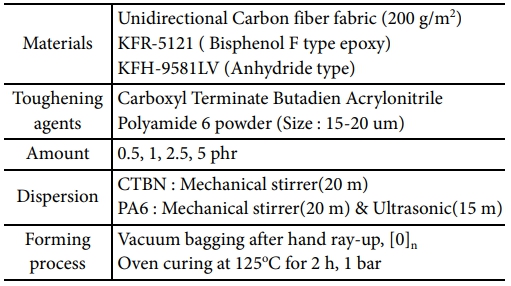
 Copyright ⓒ The Korean Society for Composite Materials. All rights reserved.
Copyright ⓒ The Korean Society for Composite Materials. All rights reserved.